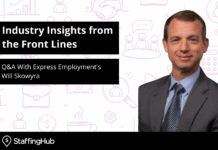
In a market that’s been flooded with new staffing technologies, Dan Mastropolo, founder of Oak City Advisors, believes most firms are drowning in shiny objects while missing the strategic foundation needed to make technology truly deliver ROI. As teams struggle with tech overwhelm and costly implementation failures, Mastropolo has built a practice around helping staffing firms cut through the noise and build scalable systems that actually work.
At this year’s Avionté CONNECT conference, where Mastropolo led a session called “Beyond the ATS,” we explored the critical gap between technology adoption and strategic execution. From navigating the build-versus-buy dilemma to understanding why clear strategic planning separates successful implementations from expensive failures, his insights reveal how firms can stop reacting to tech problems and start building infrastructure designed for growth.
Q. You’re speaking at CONNECT this year — what kinds of conversations are you having with tech leaders and execs? What’s top of mind?
Dan Mastropolo: The conversations have been exciting. The theme of this conference has been a time of uncertainty, and a lot of the owners that we work with really feel that, especially on the technology side.
We’re in this world where we have so much tech penetrating the market at a rapid rate. I think over 1,200 technologies have come into the space within the last three years, and a lot of leaders are asking for help more than anything, whether they’re from inside or outside the industry. Many of them are just trying to analyze where AI is moving the market. How is it going to impact the way we do business? Others are looking at tools that make it easier to streamline efficiencies.
But the overarching theme is their teams are behind in technology and technology leadership. They feel the pressure from their executive teams or ownership groups to make the right decisions, but they also feel like they don’t have the right resources. Or they’ve been lied to about what the technology can do, and now it’s on their dime to get the tech to do what it’s supposed to.
From an Oak City perspective, we sit in a position of “been there, done that, touched it.” Let’s help you make those decisions, without necessarily needing full-blown tech resources. Oak City provides more of a fractional resource to help either with integrations or consulting, to vet tech decisions and make sure the company is actually ready to bring those technologies in.
Q. Where do you see mid-market firms getting stuck when it comes to building internal tech leadership?
DM: To me it’s the infamous question of build versus buy. Mid-sized companies are typically the ones that are essentially intimidated with the product-to-product type marketplace, integrations or product mixes. Avionté has a really robust marketplace, and there are plenty of partners — like Sense, Staffing Referrals, or Timerack — integrations you sign up for, you turn the switch on, and it’s up and running.
However, every single business has their own unique challenges. It could be the way the clients operate — maybe they want a pay cycle of Monday to Sunday versus Sunday to Saturday, or whatever the case may be — that makes the adoption rates challenging. A lot of firms want to bring meaningfulness to their operations, recruiting, or sales arms, but very few times are all of those people aligned on exactly how things need to come together.
They make costly mistakes because they agree to bring these things in, they think they’ll be given a runway to do it, and then something happens where the recruiting team says it doesn’t do exactly what they want to do, while sales may be happy with it. Without the leadership truly understanding and being clear about the vision of where their firm is heading, you see things break down. It can be very costly, where now you may buy when you could have just built.
Essentially, it’s just really difficult for people to navigate all those changes, and the grass isn’t always greener on the other side. If you can stay committed and get that executive team buy-in, you’re able to align on how you’re tracking the ROI. But navigating all that is still a gap for a lot of these firms.
Q. When you say “beyond the ATS,” what does that mean for a firm trying to scale its infrastructure?
DM: A lot of times, we think the ERP or the ATS is supposed to do everything. And in certain cases, that’s the case. But because of how fragmented the staffing industry is, a lot of companies end up with a large tech stack. I’ve seen as many as 40 technologies in some firms.
We always try to break it down for our clients like this: you have attract-engage-hire, but then there’s a whole other set of challenges once you place people on assignment. Now we’re in co-employment, we have risk and compliance regulations, and there are labor laws to ensure you’re paying and billing appropriately. But the landscape of compliance is changing substantially.
AI is expediting the evolution of those things, and it’s making it difficult to have one comprehensive solution. When you increase automation, you have to pay attention to how things are interacting. If you have bad data, your firm now has an exponentially higher risk of compliance issues, because a lot of times you press the buttons on automation without knowing what’s hidden in those skeletons.
For example, there are all these AI note recorders listening in on meetings now. That’s becoming a major liability for wiretapping lawsuits and increasing risk. We don’t natively think about the risk — it’s just a shiny object that we know we need to have to evolve. You need the ability to bucket that risk.
This is where it helps to have confident advisors who can guide you in getting all of the moving pieces working together, putting safeguards in place to make sure you’re not taking on an exorbitant amount of risk when trying to evolve, and navigating the grey areas of emerging technology.
Q. You’ve helped a lot of firms clean up data, streamline workflows, and drive real ROI. What separates the teams that follow through from the ones that stall out?
DM: The one biggest difference is teams that have very clear strategic plans. They know what they want to accomplish in the one-, three-, and five-year runways.
Those teams tend to do a little bit better than the companies that just come and say, “I want a HubSpot integration.” Or “I need to connect my sales channel in my ERP. My ops people need to know what’s going on in sales.” They also need a plan for how they’re going to track the success of it. Yes, we can get streamlined efficiencies, typically in hours reduced or elimination of people or processes.
But sometimes when you’re looking at the boards of these executive groups, they have an actual financial number that’s tied to these things. What I’ve learned in this lifetime of doing this is if we expect the number to be 5x in two years, it’s probably closer to 2.5x in five or 2x in 10 years. It’s always longer, and a lot of that is due to operational misalignment.
So what Oak City Advisors does in these situations is sit down and get involved at the leadership level, because it’s important that we as the consultants understand that those things are in place. Or we challenge them that if they have X amount of dollars allocated for a project, they need to go back to the basics and understand and clarify how they’re going to manage it and what their expected outcomes are. Then we can build it with the ability to track those things.
So companies that stay more aligned are much more successful, and their leadership’s messaging to their teams is very clear and well understood. We’ve seen pretty substantial growth for these companies.
Q. When a staffing firm decides it’s time to make a tech change — where should they actually begin?
DM: Most of the time, staffing agencies are contemplating a tech change because something’s not working, and they have an expected outcome they think they’ll be able to achieve by making the change.
But sometimes people who have put their stacks together have gone more into a buy versus build. They’re buying certain things, but they’re not negligent that the rate of technology coming into the ecosystem is evolving, and there could be something better that comes out. So it’s a lot better for a strategy of one in, one out. Because it’s expensive to build and start making that shift to a tech-enabled staffing firm or a full-blown technology type of company.
The communication layer’s a prime example. Most people associate it with just the top of the funnel, but it’s not. It’s a portion of attract-engage-hire, but it also impacts redeployment. It also impacts being able to communitize what I consider the secret sauce of an agency. We could all be partners of Avionté, all have similar tech, but what makes a staffing company unique is their people, their processes, and how they communitize their agency to be a differentiator in whatever problem they’re solving in the market.
All that impacts how things are built, as well as how successful companies are at identifying what tech is worth putting the time, focus, and attention into.
Q. With so much happening around AI and automation, where do you see the most meaningful opportunities for staffing firms?
DM: This is an unpopular question for Dan, the reason being that I have a different opinion on it than most.
You’re seeing AI get pitched every five seconds, and it’s almost 100% top of the funnel. It’s always in this attract-engage-hire perspective. Most of those who are leading growing firms and that upper echelon of high-volume growth don’t have a problem at the top of the funnel. So they’ve piloted quite a few different things. They hypothesized that we were going to reverse-engineer supply chain problems, meaning they could 10x their candidate supply, but the clients could never onboard the X number they were driving.
So, in my opinion, you have a better chance at success by thinking of AI like a digital twin and using AI more as an agent to support your sales, finance, compliance, HR, and recruiting teams. Because at the end of the day, each one of them that’s siloed in the business has a unique challenge, or there are inefficiencies because of the fragmentation of either the tech or the way that the business operates.
So I’m really excited to see that some of the bigger products coming in are coming back to that communication channel, because we have the ability to put agents in Teams, Meet, or Slack — the way teams should be collaborating based on what’s happening behind the scenes. The companies that pay attention to this are going to see quicker adoption and more standardization of how they want their teams to be working. A lot of that comes down to structured data that’s in a position to be used that way. But it will have a higher impact than just saying, “I’m going to automatically put a voice AI or component in my recruiting, and the AI tool is going to do a better job than my human.” There has to be a balance.
Q. For a firm that’s tech overwhelmed or mid-migration — what’s one principle you’d want them to keep in mind?
DM: The biggest one for me has always been pushing people back to the strategic plan. A lot of people don’t actually take the time to strategically plan and make the vision clear — where they’re heading, how they’re getting there, and how they’re going to tell that story internally to get everybody on the same page.
What ends up happening is people start to make some noise based on whatever desk they’re sitting in and whatever the flavor of the day is. Those things can be distracting, especially at an executive level when you’re trying to listen to everybody.
But when you have the strategic plan in place, you can clearly ask the question, “Is this supporting the goal, or is it distracting the goal?” It makes it a lot easier to keep your teams aligned, make sure that you have that buy-in, and ensure the messaging is clear down to the work. This alignment supports greater efficiencies and adoption, better implementations, and more clarity on how you’re utilizing these tools and resources to maintain how you’re tracking the overall adoption and ROI.
It’s always been my cardinal rule that companies that stay true to that strategic plan always grow 10x or bigger. It’s the foundational principle of scaling up the rhythm systems. I’ve now grown close to nine companies off of that model, so it’s been the staple of my career.
Connect with Dan Mastropolo and learn more about Oak City Advisors‘ consulting services for staffing firms ready to scale their tech infrastructure strategically. You can also hear more from Dan on The Staffing Show.
Interested in attending CONNECT 2026? Follow Avionté for updates.





